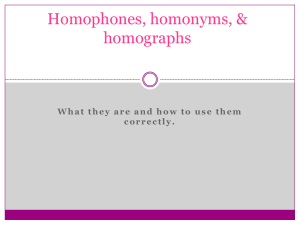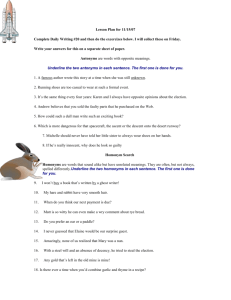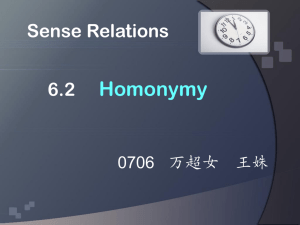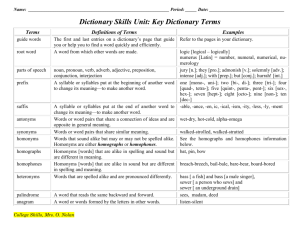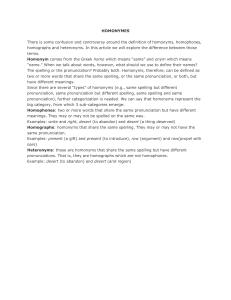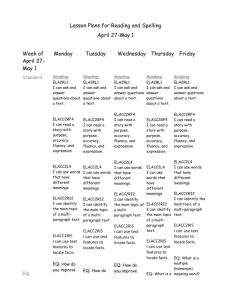In linguistics, a homonym is, in the strict sense, one of
advertisement
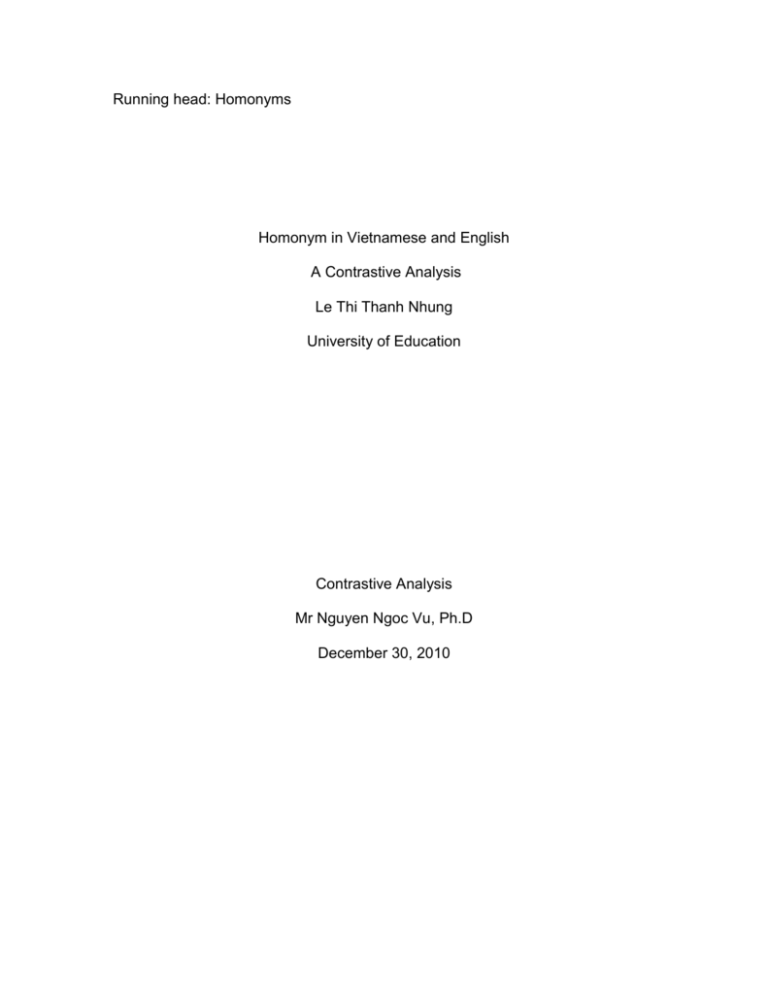
Running head: Homonyms Homonym in Vietnamese and English A Contrastive Analysis Le Thi Thanh Nhung University of Education Contrastive Analysis Mr Nguyen Ngoc Vu, Ph.D December 30, 2010 Homonym Language is vital to our life. In my research, I focus on the very small part of language: Homonyms. However, it accounts for a very important position, As an English learner, I am myself trapped in mistakes related to this topic. I hope that it’s a useful and necessary subject to do research ,make my readers clear about all the similarities and differences of English and Vietnamese consonants so that they can avoid making mistakes in their comparisons between Vietnamese and English. 1 Homonym In linguistics, a homonym is, in the strict sense, one of a group of words that share the same spelling and the same pronunciation but have different meanings, a pair, sometimes a triplet, The term is derived from Greek “homonymous” (homos - “the same” and onoma “name”) and thus expresses very well the sameness of name combined with the difference in meaning Accordingly, Professor A.I. Smirnitsky classifieds homonyms into two large classes: a) full homonyms b) partial homonyms Full homonyms Full lexical homonyms are words, which represent the same category of parts of speech and have the same paradigm. Match n - a game, a contest Match n - a short piece of wood used for producing fire Wren n - a member of the Women's Royal Naval Service Wren n - a bird Partial homonyms Partial homonyms are subdivided into three subgroups: A. Simple lexico-grammatical partial homonyms are words, which belong to the same category of parts of speech. Their paradigms have only one identical form, but it is never the same form, as will be soon from the examples: (to) found v found v (past indef., past part. of to find) (to) lay v lay v (past indef. of to lie) (to) bound v 2 Homonym bound v (past indef., past part. of to bind) B. Complex lexico-grammatical partial homonyms are words of different categories of parts of speech, which have identical form in their paradigms. Rose n Rose v (past indef. of to rise) Maid n Made v (past indef., past part. of to make) Left adj Left v (past indef., past part. of to leave) Bean n Been v (past part. of to be) One num Won v (past indef., past part. of to win) C. Partial lexical homonyms are words of the same category of parts of speech which are identical only in their corresponding forms. to lie (lay, lain) v to lie (lied, lied) v to hang (hung, hung) v to hang (hanged, hanged) v to can (canned, canned) (I) can (could) 3 Homonym bow – a long wooden stick with horse hair that is used to play certain string instruments such as the violin bow – to bend forward at the waist in respect (e.g. "bow down") bow – the front of the ship (e.g. "bow and stern") bow – the weapon which shoots arrows (e.g. "bow and arrow") bow – a kind of tied ribbon (e.g. bow on a present, a bowtie) bow – to bend outward at the sides (e.g. a "bow-legged" cowboy) The Concise Oxford Dictionary” has five entries for box: box1 n ‘a kind of small evergreen shrub’; box2 n ‘receptacle made of wood, cardboard, metal, etc. and usually provided with a lid’; box3 v ‘to put into a box’; box4 n ‘slap with the hand on the ear’; box5 v — a sport term meaning ‘to fight with fists in padded gloves’. Such homonyms may be partly derived from one another but their common point of origin lies beyond the limits of the English language. In these words with the appearance of a new meaning, very different from the previous one, the semantic structure of the parent word splits. The new meaning receives a separate existence and starts a new semantic structure of its own. Homonymy exists in many languages, but in English it is particularly frequent, especially among monosyllabic words. In the list of 2540 homonyms given in the “Oxford English Dictionary” 89% are monosyllabic words and only 9.1% are words of two syllables. From the viewpoint of their morphological structure, they are mostly one-morpheme words. The classification: Based on the number of meanings the word possesses. More detailed semantic classifications are generally based on the semantic similarity (or polarity) of words or their component morphemes. In a looser, non-technical sense, the term "homonym" can be used to refer to two different kinds of words: a)Homographs: words that share the same spelling (irrespective of their pronunciation) In the same pronunciation, in which case all homographs are also homonyms). Examples: (1) bear (verb) – to support or carry bear (noun) – the animal In (1) the words are identical in spelling and pronunciation, in this case all homographs are also homonyms, but differ in meaning and grammatical function. (2) sow (verb) – to plant seed sow (noun) – female pig 4 Homonym (2) is an example of two words spelt identically but pronounced differently. Here confusion is not possible in spoken language but can occasionally occur in written language. b)Homophones: words that share the same pronunciation (irrespective of their spelling). If they are spelled the same then they are also homographs (and homonyms), Examples: rose (flower) and rose (past tense of "rise") or differently, homophones that are spelled differently are also called heterographs Examples: carat, caret, and carrot, or to, two, and too. Whole sentences may be homophonic: The sons raise meat - The sun's rays meet. To understand these one needs a wider context. If you hear the second in the course of a lecture in optics, you will understand it without thinking of the possibility of the first. Vietnamese is not an inflectional language so that in every situation, the homonym is the same while English, an inflectional language, may be homonymous in this format but in other format it’s not. Examples: 1) Meat /mi:t/ the flesh of animals (including fishes and birds and snails) used as food Meet /mi:t/ come together. 2) Saw/sɔ Saw [sɔ :/ :]the past form of “see” But in the past form of “meet”, these two homonyms are no longer homonymous: Met ≠Meat Similar: See ≠ Saw 5 Homonym Combinations when two or more meanings are possible are either deliberate puns, or result from carelessness. Both meanings of liver, i.e. `a living person' and `the organ that secretes bile' are, for instance, intentionally present in the following play upon words: 1. “Is life worth living?” ”It depends upon the liver. Sources of homonyms: The intense development of homonymy in the English language is obviously due not to one single factor but to several interrelated causes, such as the monosyllabic character of English and its analytic structure -Phonetic changes: words undergo in the coarse of their historical development. As a result of such changes, two or more words, which were formally pronounced differently, may develop identical sound forms and thus become homonyms: night & knight, were not homonyms in Old English as the initial k in the second word was pronounced, and not dropped as it is in its modern sound form -Borrowing: Match, n `a game; a contest of skill, strength' is native match, n `a slender short piece of wood used for producing fire' is a French borrowing. -Word building comb, n - to comb, v; pale, adj - to pale, v; to make, v - make, n are numerous in the vocabulary. Homonyms of this type, which are the same in sound and spelling but refer to different categories of parts of speech, are called lexicogrammatical homonyms. -Shortening: rep, n (< repertory), rep, n (< representative), rep, n (< reputation) -Disintegration or split of polysemy. Conclusion: The abundance of homonyms is also closely connected with such a characteristic feature of the English language as the phonetic identity of word and stem or, in other words, the predominance of free forms among the most 6 Homonym frequent roots. It is quite obvious that if the frequency of words stands in some inverse relationship to their length, the monosyllabic words will be the most frequent. Moreover, as the most frequent words are also highly polysemantic, it is only natural that they develop meanings which in the course of time may deviate very far from the central one. When the intermediate links fall out, some of these new meanings lose all connections with the rest of the structure and start a separate existence. The phenomenon is known as disintegration or split of polysemy. Different causes by which homonymy may be brought about are subdivided into two main groups: 1) homonymy through convergent sound development, when two or three words of different origin accidentally coincide in sound; and 2) homonymy developed from polysemy through divergent sense development. Both may be combined with loss of endings and other morphological processes. In Vietnamese: The classification of homonyms is different. a)Homonyms- Word: all the units join the homonyms group belongs to word. There are two small groups: a.1.Homonyms-vocabulary: all belongs to this are the same kind. +đường1: (đắp đường) +đường kính1 : ( a kind of sugar) + đường2: ( a kind of sugar) +đường kính2 : ( diameter) a.2 Homonyms-grammar: all the units join the homonyms group are different kind. +chỉ 1: (cuộn chỉ : a noun ) +chỉ 2:( chỉ tay năm ngón : a verb) +chỉ 3:( chỉ còn có dăm đồng: a adverb) +câu 1: (nói vài câu : a noun) + câu 2: (câu cá: a verb ) + câu 3: ( rau câu : an adjective) 7 Homonym This kind of homonym accounts for a large proportion. b) Homonyms-language: In Vietnamese, there’s no conflict between the roots with affix so the word is composed of language, so does the homonym. Examples: -Con trai Văn Cốc lên dốc bắn cò, đứng lăm le cười khanh khách. Con gái Bát Chàng bán hàng thịt ếch ngồi châu chẫu nói ương ương. -Nhà cửa để lầm than con thơ trẻ lấy ai rèn cặp Cơ đồ đành bỏ bễ vợ trẻ trung lắm kẻ đe loi. Sources of homonyms: Most of the homonyms are unable to chase the origin, but some are: -Most of them are native: Bay(D)-bay(Đ); rắn(T)-rắn(D); đá(D)-đá(Đ); sắc(T)sắc(Đ)…are native Vietnamese. -Borrowing: Sút 1: ( decrease, Vietnamese origin) Sút 2: ( shoot ball, English origin) -The derivative formation by the affix. “Đỏ thắm, đỏ tươi, đỏ chói…” are derivatives of “đỏ”. -The meaning separation of polysemy: the unrelated meaning from the original word. We have the pair of homonym from the breaking of the meaning. Qùa 1: ( the snack) Qùa 2: ( the present) - Word form conversion: from verb into noun, adjective… Others: historical phonic change, dialect from Northern Examples Lời ( sentence, saying) 8 Homonym Lợi lời ( benefit) Che =tre (bamboo ) Da= ra (out) Che Da (cover, hide) ( skin) Conclusions: Vietnamese, it’s rarely to have distinction between the homonyms and polysemy. Just based on the origin, if two words have different origin, same pronunciation, they are homonyms.With the same origin and pronunciation, they maybe polysemy. The criteria in classifying the homonym with polysemy is etymology. It’s not easy to chase the etymology -Next criteria is the broken off of meaning is not always clear and subjective. -Studying carefully the homonyms in theory and practice is necessary; especially in dictionary and translation. In general communicative language, the homonyms have their own nuance, used specially in word play Bà già ra chợ Cầu Đông Xem một quẻ bói lấy chồng lợi(1) chăng Thấy bói gieo quẻ nói rằng: Lợi thì có lợi (2)nhưng răng chẳng còn Lợi (1) :good, advantage Lợi (2) gums Cóc chết bỏ nhái mồ côi, Chẫu ngồi chẫu khóc: chàng ơi là chàng! Ễnh ương đánh lệnh đã vang, Tiền đâu mà trả cho làng, ngoé ơi! The fine word play here is the five homonyms about animals in a poem: cóc, nhái, chẫu chàng, ễnh ương, ngóe… Through a contrastive view into Vietnamese and English homonyms, differences and similarities between them as mention above, I would like to 9 Homonym discuss some implications for English and Vietnamese teaching at high school in our country. - Homonym requires a special attention of teachers to be adequated to their specialization in English, take into consideration both the spelling and the pronunciation of words when analyzing cases of identity of form and diversity of content - English teachers should provide input as much as possible to develop student’s cultural competence. - Raise the students’ awareness when they do the translation so as not to make mistake, in writing, too. Sometimes these mistakes can be fatal because it changes the meaning. Examples: “Tom wasn’t sure, but in the end it proved the right root to take.” “Tom wasn’t sure, but in the end it proved the right route to take.” The first suggests that Tom didn’t poison himself, because he chose the right root vegetable to take for his supper. The second suggests Tom didn’t get lost because it was the right route home. -As a teacher-to-be, thevery best way to avoid mixing your homonyms is to use a thesaurus -We can applying homonyms in making games, homonym lend themselves to matching worksheets. These can be done by matching the actual homonyms or by matching the correct definition to the correct word. Both ways of testing understand are required for the skill set to be met. - Homonymscan bring confusion to even adults and teachers! For clarity, we've brought them all together and made a word play game Playing with such jokes encourages flexibility in the use of metaphor, and introduces us to logic, and can give us practice with the composition of narratives, and helps students understand what homonyms are and what problems and benefits they can have for our language uses. -Know how to use, spell the homonyms in every situation, sentence. It also depends on the content, the uses of the homonyms. 10 Homonym Reference Mai Ngọc Chừ; Vũ Đức Nghiệu & Hoàng Trọng Phiến. Cơ sở ngôn ngữ học và tiếng Việt. Nxb Giáo dục, H., 1997. Homonym from http://en.wikipedia.org/wiki/Homonym Homonymy in English from http://revolution.allbest.ru/languages/00000517_0.html The origin of Homonyms from http://englishschool12.ru/publ/grammatika_anglijskogo_jazyka/grammatika_anglij skogo_jazyka/the_origin_of_homonyms/63-1-0-2057 11

